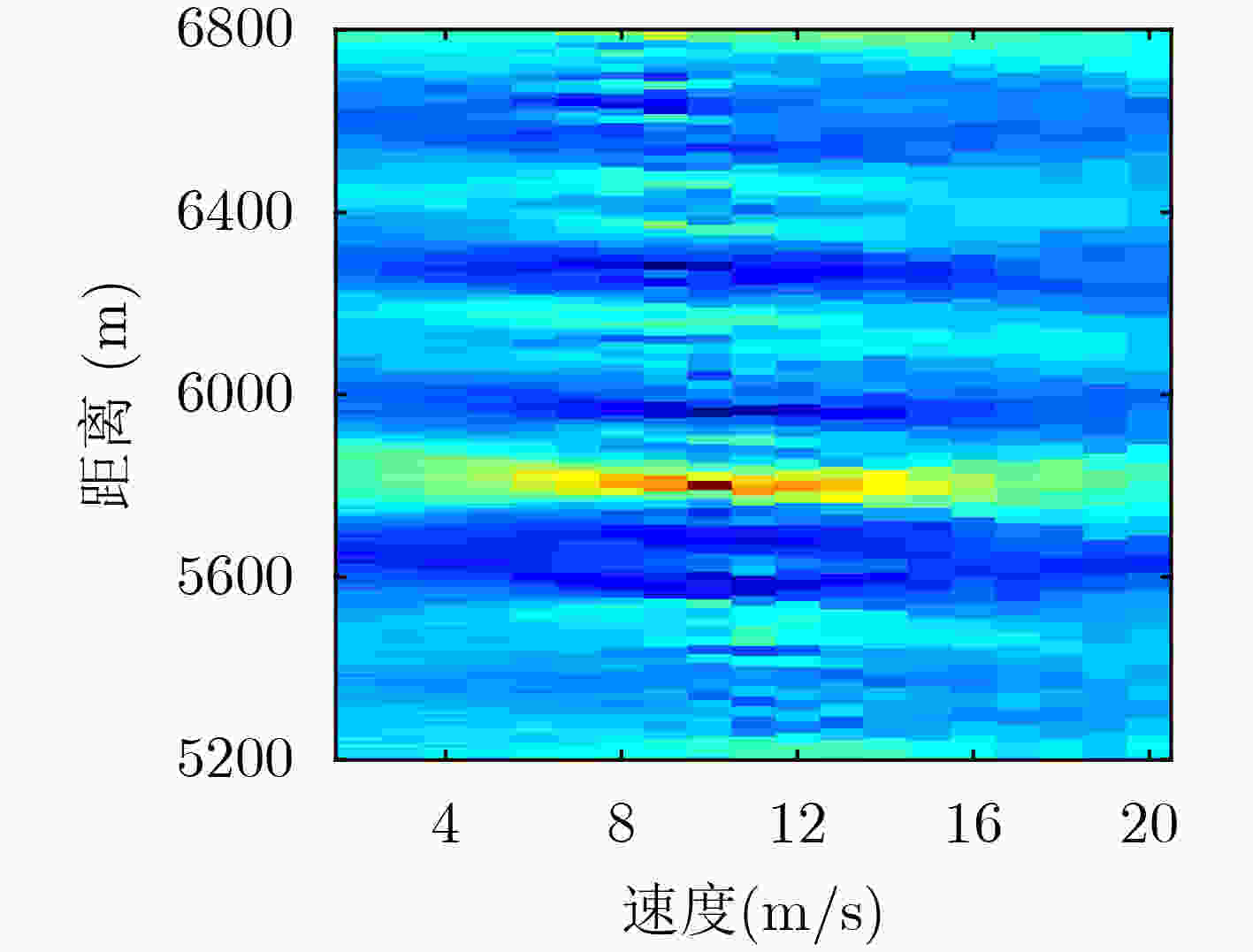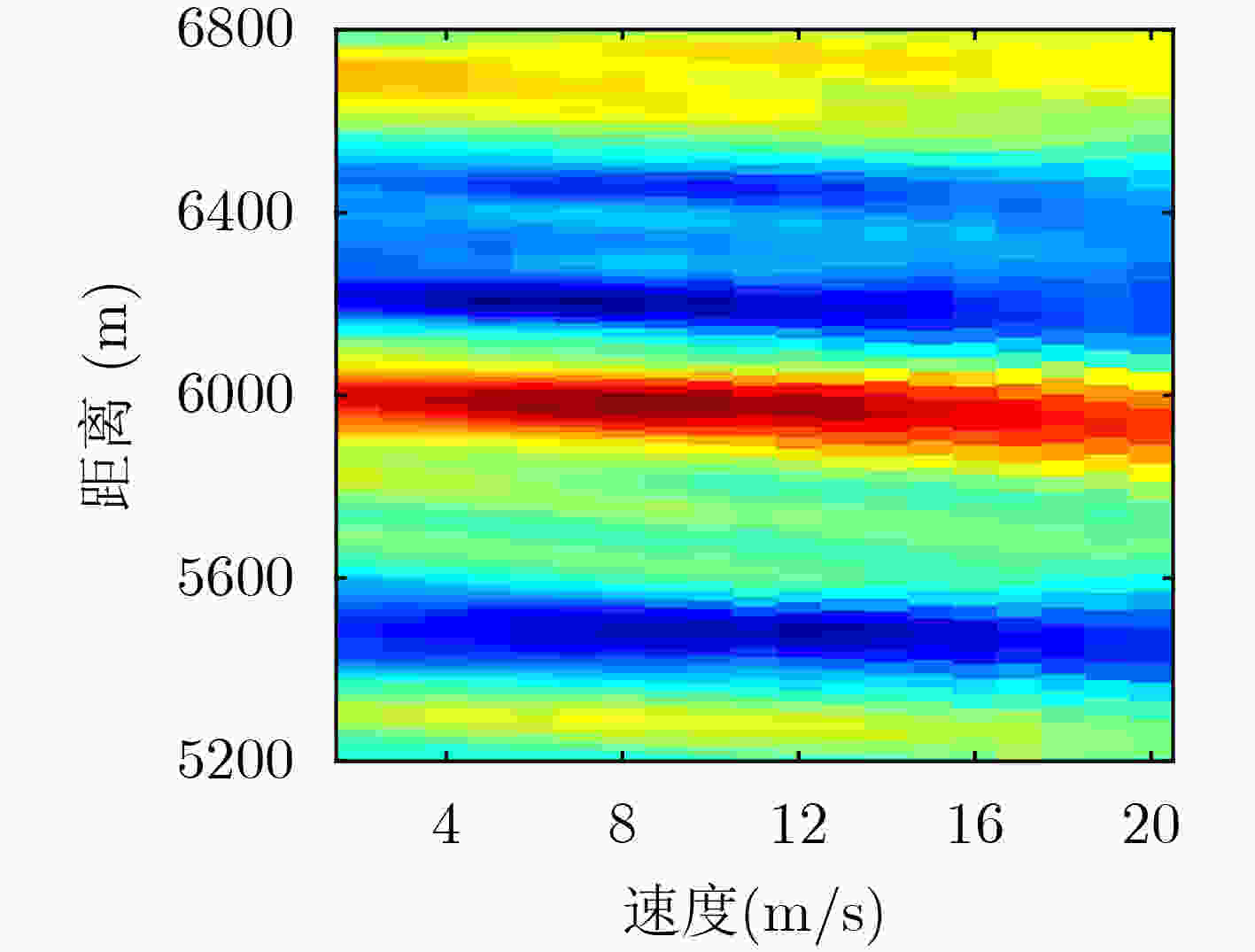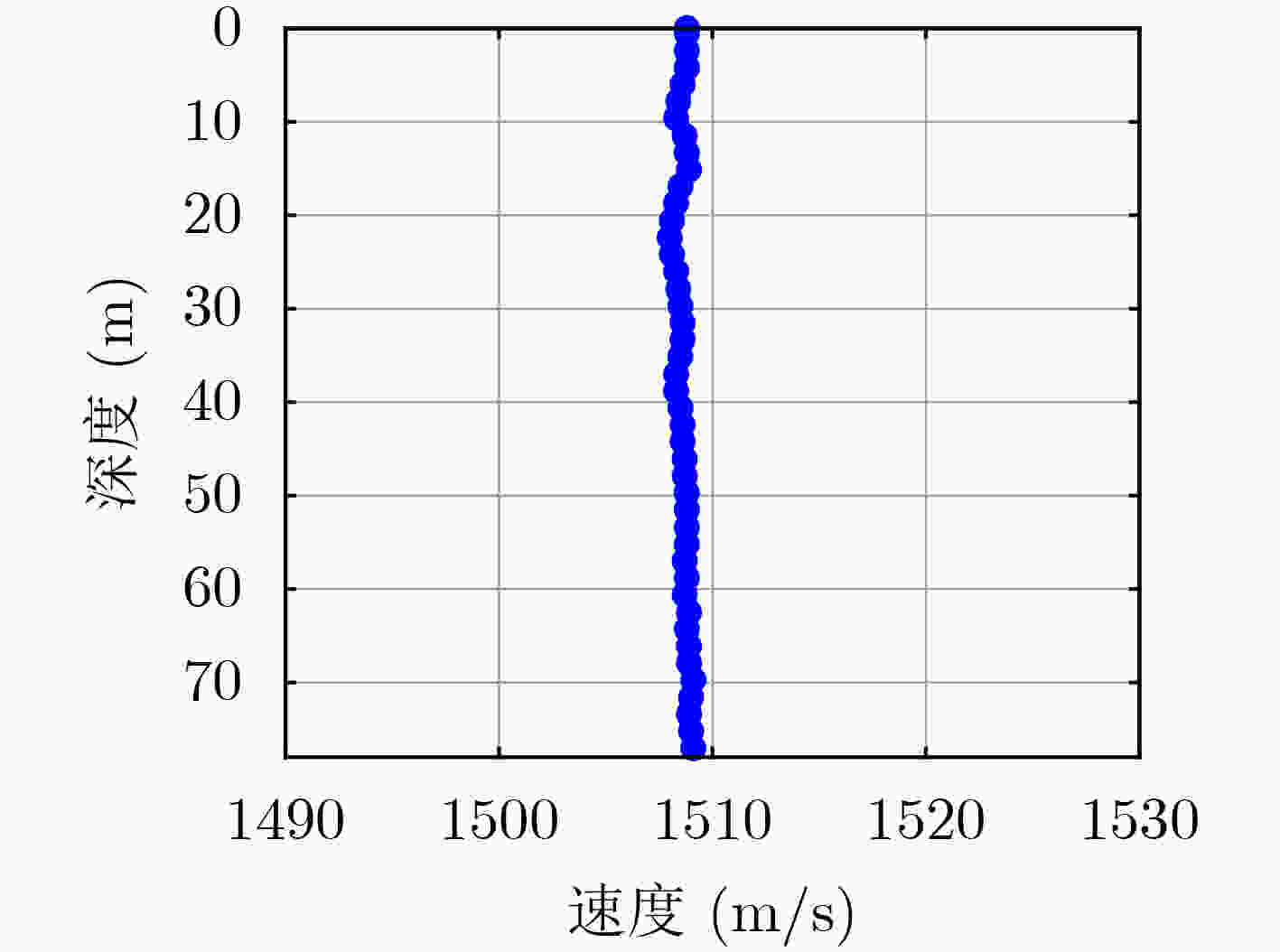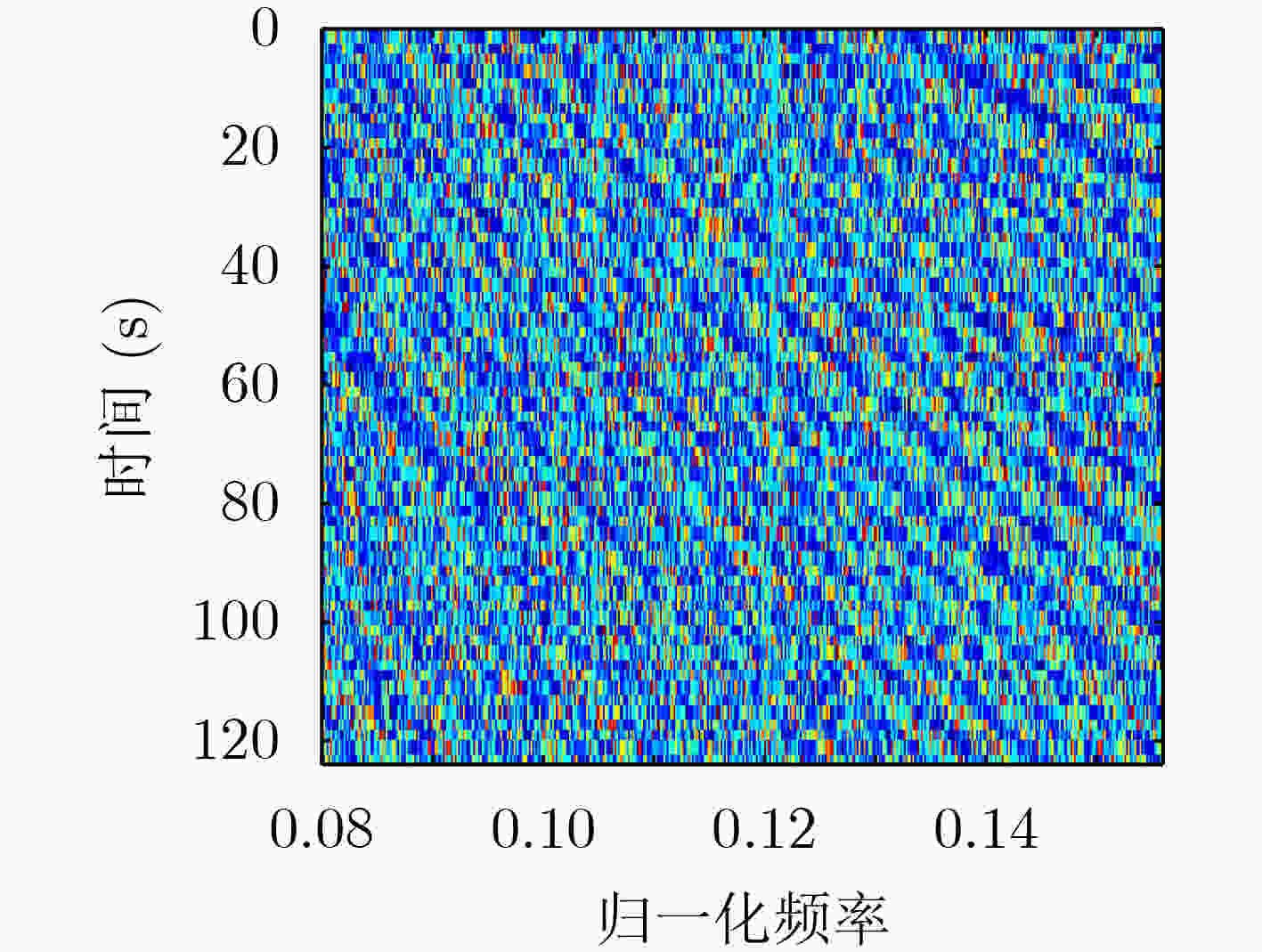A Distance and Velocity Estimation Method for Sound Source Based on Interference Field Matching
-
摘要: 浅海环境中运动目标可以生成稳定的干涉声场,干涉声场结构中蕴含目标的距离、速度等信息。该文提出一种利用运动目标干涉声场进行被动距离速度估计的方法——匹配干涉场处理方法。首先对浅海波导环境中的干涉现象和结构特性进行理论分析,推导了匹配干涉场方法聚焦原理。然后将运动目标的时间-频率干涉场转换成与目标距离速度相关的距离-频率干涉场,与拷贝声场进行相关处理实现目标距离速度同时估计。进一步分析了算法估距性能以及海深、声速剖面、海底海面等环境对估距性能的影响,给出了算法宽容性的仿真结论。最后通过实际运动目标的海上试验数据处理验证了所提方法的有效性。Abstract: Moving target in shallow sea environment can generate stable interference sound field, which contains information such as target distance and velocity.In this paper, a method of passive distance and velocity estimation based on moving target interference sound field is proposed. First, the interference phenomenon and structure characteristics in shallow sea waveguide are analyzed theoretically, and the focusing principle of matching interference field method is deduced. Then, the time-frequency interference field of the moving target is transformed into range-frequency interference field which is related to the target range and velocity, and the distance and velocity of the target are estimated simultaneously by correlative processing with the copy sound field. Further, the value distance performance of the algorithm and the influence of sea depth, sound velocity profile, sea surface and other sound field parameters on the value distance performance are investigated through simulation, and the simulation conclusion of the algorithm tolerance is given. At last, the validity of the algorithm is verified by the data of practical target at sea.
-
表 1 典型海底底质地声参数
序号 海底沉积物
类型密度(g/cm3) 压缩波速(m/s) 切变波速(m/s) 孔隙率
(%)1 细砂 1.98 1742 382 43.9 2 极细砂 1.91 1711 503 47.4 3 粉砂 1.83 1677 467 52.8 4 细粉砂 1.56 1552 379 68.3 5 粉砂质粘土 1.42 1519 287 76 -
[1] 马远良. 匹配场处理——水声物理学与信号处理的结合[J]. 电子科技导报, 1996(4): 9–12.MA Yuanliang. Matching field processing—Combination of underwater acoustic physics and signal processing[J]. Elec Sci Tech Rev, 1996(4): 9–12. [2] 王静, 黄建国, 管静. 水声信号处理中匹配场处理技术研究的现状和展望[J]. 声学技术, 2000, 19(1): 34–38. doi: 10.3969/j.issn.1000-3630.2000.01.010WANG Jing, HUANG Jianguo, and GUAN Jing. An survey of matched-field processing in acoustical signal processing[J]. Technical Acousitics, 2000, 19(1): 34–38. doi: 10.3969/j.issn.1000-3630.2000.01.010 [3] 杨坤德. 水声阵列信号的匹配场处理[M]. 西安: 西北工业大学出版社, 2008. [4] YANG T C. Beam intensity striations and applications[J]. The Journal of the Acoustical Society of America, 2003, 113(4): 1342–1352. doi: 10.1121/1.1534604 [5] COCKRELL K L and SCHMIDT H. Robust passive range estimation using the waveguide invariant[J]. The Journal of the Acoustical Society of America, 2010, 127(5): 2780–2789. doi: 10.1121/1.3337223 [6] 李启虎. 水下目标被动测距的一种新方法: 利用波导不变量提取目标距离信息[J]. 声学学报, 2015, 40(2): 138–143. doi: 10.15949/j.cnki.0371-0025.2015.02.004LI Qihu. A new method of passive ranging for underwater target: Distance information extraction based on wave guide invariant[J]. Acta Acustica, 2015, 40(2): 138–143. doi: 10.15949/j.cnki.0371-0025.2015.02.004 [7] 黄冠钦, 杨坤德. 一种波导不变量的被动定位方法[J]. 鱼雷技术, 2013, 21(4): 268–271. doi: 10.3969/j.issn.1673-1948.2013.04.007HUANG Guanqin and YANG Kunde. A passive positioning method using waveguide invariant[J]. Torpedo Technology, 2013, 21(4): 268–271. doi: 10.3969/j.issn.1673-1948.2013.04.007 [8] 任云, 戚聿波, 周士弘, 等. 声强谱频移补偿的波导不变量和距离估计方法[J]. 声学学报, 2014, 39(3): 319–323. doi: 10.15949/j.cnki.0371-0025.2014.03.002REN Yun, QI Yubo, ZHOU Shihong, et al. Waveguide invariant and range estimation based on frequency-shift-compensation of underwater acoustic intensity spectrograms[J]. Acta Acustica, 2014, 39(3): 319–323. doi: 10.15949/j.cnki.0371-0025.2014.03.002 [9] 王家鑫, 王南, 夏平. 浅海波导下水平直线阵被动测距技术[J]. 声学与电子工程, 2018(3): 4–8,33.WANG Jiaxin, WANG Nan, and XIA Ping. Passive ranging technique of horizontal linear array under shallow sea waveguide[J]. Acoustics and Electronics Engineering, 2018(3): 4–8,33. [10] 余赟. 浅海低频声场干涉结构及其应用研究[D]. [博士论文], 哈尔滨工程大学, 2011.YU Yun. The interference structure of shallow water low-frequency acoustic field and its application[D]. [Ph. D. dissertation], Harbin Engineering University, 2011. [11] 余赟, 袁延艺, 刘雄厚. 利用波导不变量进行运动单线阵的无源测距测速[J]. 声学学报, 2017, 42(6): 661–668. doi: 10.15949/j.cnki.0371-0025.2017.06.003YU Yun, YUAN Yanyi, and LIU Xionghou. Passive ranging and velocity estimation using a moving hydrophone array based on the wave guide invariant[J]. Acta Acustica, 2017, 42(6): 661–668. doi: 10.15949/j.cnki.0371-0025.2017.06.003 [12] 徐国军, 笪良龙, 赵建昕, 等. 声场干涉结构相似度匹配的目标运动参数估计[J]. 声学学报, 2020, 45(4): 527–534. doi: 10.15949/j.cnki.0371-0025.2020.04.009XU Guojun, DA Lianglong, ZHAO Jianxin, et al. The target motion parameters estimation based on the acoustic interference structure similarity match[J]. Acta Acustica, 2020, 45(4): 527–534. doi: 10.15949/j.cnki.0371-0025.2020.04.009 [13] 宋雪晶. 基于声场干涉结构的水声目标被动定位技术[D]. [博士论文], 哈尔滨工程大学, 2017.SONG Xuejing. Underwater acoustic target passive localization techniques based on acoustic field interference structure[D]. [Ph. D. dissertation], Harbin Engineering University, 2017. [14] 宋雪晶, 赵安邦, 马骏, 等. 基于波导不变量的单水平阵被动测距技术[J]. 系统工程与电子技术, 2016, 38(10): 2252–2257. doi: 10.3969/j.issn.1001-506X.2016.10.05SONG Xuejing, ZHAO Anbang, MA Jun, et al. Passive ranging with horizontal array based on waveguide invariant[J]. Systems Engineering and Electronics, 2016, 38(10): 2252–2257. doi: 10.3969/j.issn.1001-506X.2016.10.05 [15] 杜选民, 周胜增, 高源. 声纳阵列信号处理技术[M]. 北京: 电子工业出版社, 2018: 156–159.DU Xuanmin, ZHOU Shengzeng, and GAO Yuan. Array Signal Processing Techniques for Sonar[M]. Beijing: Publishing House of Electronics Industry, 2018: 156–159. [16] 高大治, 翟林, 王好忠, 等. 利用线谱起伏实现目标测距[J]. 声学学报, 2017, 42(6): 669–676. doi: 10.15949/j.cnki.0371-0025.2017.06.004GAO Dazhi, ZHAI Lin, WANG Haozhong, et al. Passive ranging using the fluctuation of target tonal acoustic intensity[J]. Acta Acustica, 2017, 42(6): 669–676. doi: 10.15949/j.cnki.0371-0025.2017.06.004 [17] 魏德凯, 朱代柱, 郭浩泉. 基于线谱幅值起伏的目标被动定位技术研究[J]. 声学与电子工程, 2019(4): 33–36.WEI Dekai, ZHU Daizhu, and GUO Haoquan. Research on passive target location technology based on line spectral fluctuation[J]. Acoustics and Electronics Engineering, 2019(4): 33–36. [18] RAKOTONARIVO S T and KUPERMAN W A. Model-independent range localization of a moving source in shallow water[J]. The Journal of the Acoustical Society of America, 2012, 132(4): 2218–2223. doi: 10.1121/1.4748795 [19] 王朋, 郑胜家, 黄勇, 等. 浅海运动目标波束域波导不变量测距方法研究[J]. 声学学报, 2015, 40(6): 789–798. doi: 10.15949/j.cnki.0371-0025.2015.06.004WANG Peng, ZHENG Shengjia, HUANG Yong, et al. Range estimation based on waveguide invariant using beam intensity striations for moving target in shallow water[J]. Acta Acustica, 2015, 40(6): 789–798. doi: 10.15949/j.cnki.0371-0025.2015.06.004 [20] 邵云生, 王朋, 黄勇, 等. 浅海随机相位起伏声场中速度估计的互谱分析方法[J]. 应用声学, 2015, 34(6): 501–508.SHAO Yunsheng, WANG Peng, HUANG Yong, et al. Velocity estimation by cross-spectral analysis in a random shallow water channel[J]. Applied Acoustics, 2015, 34(6): 501–508. [21] 高源, 周胜增. 基于线谱干涉结构的运动目标速度估计研究[C]. 庆祝杨士莪院士90华诞论文集. 哈尔滨, 中国, 2020: 481–489.GAO Yuan and ZHOU Shengzeng. Velocity estimation of moving target based on line spectral interference structure[C]. Collected Papers Celebrating the 90th Birthday of Academician Yang Shie. Harbin, China, 2020: 481–489. -






 下载:
下载:


















 下载:
下载:
